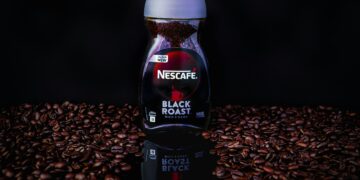Table of Contents
Part I: The Frustration of the Flat Note
For any devoted coffee enthusiast, the journey often begins with a single, revelatory cup.
It’s a moment of clarity where coffee transforms from a mere morning ritual into a world of flavor and nuance.
This journey leads inevitably to the appreciation of single-origin coffees, where the unique story of a specific place—its soil, climate, and elevation—is told in every sip.1
An Ethiopian Yirgacheffe offers a cup brimming with bright, floral, and lemon notes, a taste so distinct it feels like a sensory snapshot of its origin.3
A Colombian coffee presents a smooth, balanced profile with hints of caramel and nuts, a comforting and reliable expression of its terroir.2
Mastering the art of brewing these individual coffees, understanding how grind size, water temperature, and brew time can unlock their specific character, becomes a passionate pursuit.
It’s a process of honoring the bean, of allowing its solo performance to shine.
The logical next step, the ascent to a higher plane of coffee craft, appears to be blending.
The literature of coffee speaks of it as the “true artistry,” the act of melding the unique qualities of two or more coffees to create something new, something “more than the sum of its parts”.5
The goal is not just to mix, but to achieve balance and harmony, showcasing the best notes of each component in a unified, elevated experience.6
Armed with this romantic notion and a shelf full of exceptional single-origin beans, the aspiring blender steps up to the cupping table, ready to compose a masterpiece.
This is where the frustration begins.
The initial attempts, guided by well-meaning advice, are often disastrous.
A simple blend of a light roast and a dark roast, as recommended for beginners, might yield a cup that tastes confused, with neither the bright notes of the former nor the rich depth of the latter truly present.7
Following classic recipes like the famed Mocha-Java—a historic combination of Yemen Mocha and Indonesian Java or Sumatra—can produce a result that feels like a pale imitation of its legendary reputation.5
The vibrant, fruity Ethiopian that was so spectacular on its own suddenly vanishes when combined with a chocolatey Brazilian, its distinct character seemingly “annihilated” by the other bean.1
The resulting cups are consistently described with a single, damning word: “muddy”.9
They are flat, one-dimensional, and generic—the very qualities that specialty coffee seeks to transcend.11
Instead of a harmonious chord, the blend is a cacophony of muddled flavors, where individual notes clash and cancel each other O.T.1
This experience is so common it becomes a recurring theme in online forums, where enthusiasts lament their inability to create a blend that is as good as, let alone better than, its individual components.9
The paradox is maddening: how can combining two or three beautiful things result in something worse?
This failure is not merely a matter of taste; it is rooted in unperceived technical flaws.
The “muddiness” is often a symptom of deeper issues.
One is flavor cancellation, where competing dominant notes effectively mute each other.
Another, more insidious problem is inconsistent extraction.
Beans from different origins, or even those processed differently, have varying densities, sizes, and moisture content.14
When ground and brewed together, they extract at different rates.
While one bean might be perfectly extracted, another in the same brew bed could be under-extracted (tasting sour) or over-extracted (tasting bitter), leading to a structurally imbalanced and unpleasant final cup.11
The blend lacks a clear beginning, middle, and end; it has no defined body, acidity, or aftertaste, the very pillars of a well-structured coffee.6
This persistent failure leads to a crisis of confidence.
The blender starts to question the very premise of blending, wondering if it’s an outdated practice best left to large commercial roasters who use it to hide the flavors of lower-quality coffee, cut costs, or simply use up old inventory.5
The expertise so carefully cultivated in the world of single origins feels useless.
In fact, it may even be a hindrance.
The focus on the “solo performance” of each bean, the celebration of its unique and sometimes eccentric character, makes it difficult to imagine how it could function as part of an ensemble.
The core struggle, then, is not a lack of knowledge but the application of a flawed mental model.
The approach is culinary—adding ingredients to a pot—when what is required is compositional, like arranging instruments in an orchestra.
Without a new way to think about how flavors interact, the result will always be M.D.
Part II: The Epiphany in the Mix
After countless failed experiments and a growing pile of disappointing, muddled blends, a period of creative retreat is necessary.
Stepping away from the scales, the grinder, and the cupping spoons can feel like an admission of defeat.
It is in this space of frustration and distance, however, that a breakthrough often occurs, usually from an unexpected quarter.
For the struggling coffee blender, the answer may not be found in another coffee blog or a different bag of beans, but in revisiting an entirely different craft: music production.
Imagine sitting before a digital audio workstation, looking at the multitrack layout of a song.
It is not a monolithic wall of sound.
It is a structured, three-dimensional space.
At the bottom, the bassline and kick drum provide a deep, foundational pulse—a physical, resonant throb that underpins everything.
In the center, the vocals, guitars, and keyboards weave together, creating the core melody and harmony of the track.
At the very top, the shimmering frequencies of cymbals, hi-hats, and vocal air add sparkle, detail, and a sense of atmosphere.
A professional audio engineer knows that a great mix is not achieved by making every instrument as loud as possible.
That approach leads to a “muddy” mix, where frequencies compete, mask each other, and create a dense, unintelligible sonic sludge.
The art of mixing is the art of separation.
It is about carving out a specific space in the frequency spectrum for each instrument so that it can be heard clearly and contribute to the whole without overwhelming it.16
It is about creating harmony and ensuring the final track is more than the sum of its parts—the very goal that eludes the coffee blender.5
Staring at that visual equalizer, a profound epiphany strikes.
The language of coffee and music already overlaps.
Roasters and cuppers speak of flavor “notes” and “tones”.17
A blend can be conceived as a “chord” or, as one roaster described, a “jazz trio” with distinct roles for each instrument.17
The connection is not merely poetic; it is functional.
The “Aha!” moment is this: My coffee blends are muddy for the same reason a bad music mix is muddy.
I’ve been cramming all the flavors into the same frequency space.
I haven’t been composing; I’ve just been turning everything up.
This realization provides a powerful new cognitive tool.
The abstract, frustrating problem of “muddiness” is suddenly transformed into a concrete, visual, and solvable engineering challenge.
The flavor profile of a coffee can be mapped onto an audio frequency spectrum: Bass, Mids, and Treble.
The problem is no longer “this tastes bad,” but rather, “this blend has too much competing mid-range and no foundational low-end.” It’s a shift from thinking like a chef, who combines ingredients, to thinking like a producer, who arranges sonic elements in a defined space.
This new mental model suddenly illuminates the wisdom behind all the disparate pieces of blending advice encountered before.
The rule to “start with a base” 5 is no longer an arbitrary instruction; it’s the necessity of establishing a bass frequency to give the composition weight and power.
The recommendation to use “high note” coffees sparingly 19 now makes perfect sense; too much treble in a mix is harsh and fatiguing, like cymbals crashing incessantly.
The guideline to limit a blend to three to five components 5 is revealed to be a strategy to avoid frequency masking, the sonic phenomenon where too many instruments in the same range obscure one another.
The music production analogy doesn’t just offer a clever metaphor; it provides a unifying theory that transforms a confusing list of rules into a coherent, interconnected system for creating harmony in the cup.
Part III: The Sonic Spectrum Framework: A New Theory of Blending
The epiphany that coffee blending is analogous to music production can be formalized into a practical, teachable system: The Sonic Spectrum Framework.
This framework moves beyond simple flavor pairing and provides a structural approach to composition.
It assigns each coffee component a role corresponding to a frequency range in a musical mix, allowing the blender to construct a cup with intention, balance, and clarity.
This approach finds parallels in other sophisticated crafts.
In perfumery, fragrances are built on a structure of top, middle, and base notes, which unfold over time to create a complete olfactory experience.22
The fleeting top notes are the first impression, the middle or “heart” notes form the main character, and the lingering base notes provide the foundation.22
Similarly, in winemaking, the art of
assemblage involves blending different grape varietals to balance components like tannins, acidity, and fruit, creating a final wine that is more complex and harmonious than any single varietal could be on its own.24
The Sonic Spectrum Framework is a new interpretation of this universal principle of sensory composition, applied specifically to coffee.
The Bass Frequencies (The Foundation / The Rhythm Section)
The bass is the anchor of any musical track.
It’s the kick drum and the bass guitar, providing the foundational rhythm and weight.
You might not always consciously notice it, but its absence would leave the song feeling thin and powerless.
In coffee, the Bass component serves the same function.
It provides the body, the rich mouthfeel, and the deep, resonant aftertaste that gives the blend structure and presence.5
This is the component responsible for a full, velvety, or syrupy texture.
- Flavor Profile: These are coffees characterized by low acidity and a full body. Their flavor notes are foundational and comforting: “chocolatey, nutty, caramel-y, or woody”.6 They provide a stable, sweet, and deep canvas upon which the other flavors can be painted.
- Typical Origins: Coffees from Brazil are the quintessential bass note, prized for their consistent, low-acidity, chocolate-and-nut profile.14 Other excellent choices for this role include coffees from Peru and Mexico, which also tend to offer these desirable base characteristics.19
The Mid-Range (The Melody / The Lead Instrument)
The mid-range is where the core identity of a song lives.
It’s the domain of the lead vocal, the primary guitar riff, or the main piano melody.
This is the part of the track that is most memorable and carries the central theme.
In a coffee blend, the Mid-Range component provides this “mid-palate satisfaction,” defining the blend’s principal character.20
It is the dominant, defining flavor that the drinker will identify as the heart of the coffee.
- Flavor Profile: These are well-balanced coffees that bring sweetness, a pleasant “juicy” quality, and distinct but not overpowering fruit notes. The flavor wheel for these coffees points to “sugars, dried fruit, stone fruit, apple, or pear”.6 They possess a “round, creamy, silky body and crisp, balanced acidity,” making them excellent solo artists that also play well in a group.6
- Typical Origins: Coffees from Central and South America excel in this role. A washed Colombian is a classic choice, offering balanced sweetness and body.21 Guatemalan and Honduran coffees are also frequently used to provide this melodic core of stone fruit and balanced sugars.14
The Treble (The Harmonics / The Cymbals & Effects)
The treble frequencies in music provide sparkle, brilliance, and air.
They are the shimmering cymbals, the crisp hi-hats, or the subtle sheen of a reverb effect that adds dimension and excitement to a track.
They are used with precision and often sparingly, as too much can make a mix sound harsh or thin.
The Treble component in a coffee blend plays this exact role.
It is not meant to be the dominant flavor but to lift the other components, add complexity, and create a bright, clean, and vibrant finish.
- Flavor Profile: These are high-acidity, light-bodied coffees known for their aromatic intensity and complexity. They are the source of “bright, vibrant citrus and floral notes”.6 These volatile compounds are the first to be perceived in the aroma and on the palate, analogous to the top notes in perfume.23
- Typical Origins: African coffees are the undisputed masters of the high notes. A washed Ethiopian Yirgacheffe, with its characteristic lemon and jasmine notes, is a perfect example.3 Kenyan coffees are also prized for their bright, wine-like acidity and complex fruitiness.19 These beans are almost always roasted light to preserve their delicate aromatics, as a darker roast would mute these high-frequency flavors.6 They are used in smaller percentages to add that essential sparkle without creating “citrus overkill”.28
Part IV: Composing in the Key of Coffee: The Practical Application
With the Sonic Spectrum Framework established, the process of blending transforms from guesswork into a deliberate act of composition.
The following steps use the language of music production to provide a practical, intuitive guide for creating a signature blend.
1. Setting the Levels (Ratios & Proportions)
In a recording studio, the first step in mixing is setting the volume levels of each track.
This act of balancing determines the overall feel and genre of the song.
In coffee blending, the ratio of your components serves the same purpose.
The proportion of Bass, Mids, and Treble defines the character of your final blend.
A fantastic starting point for a well-balanced, crowd-pleasing blend—the “pop song” of coffee—is a 40% Bass, 40% Mids, and 20% Treble ratio.19
This creates a cup with a solid foundation, a clear and present melody, and a touch of bright complexity.
From this starting point, one can “remix” the blend to create different styles:
- For a “bass-heavy” espresso blend, designed to be rich, deep, and cut through milk, you would increase the Bass component. A ratio of 60% Bass, 25% Mids, and 15% Treble would create a powerful, low-end-focused experience with deep cocoa flavors and a full body.21
- For a brighter, more nuanced “acoustic” filter blend, you might want to feature the higher frequencies more prominently. A ratio of 30% Bass, 40% Mids, and 30% Treble would result in a lighter-bodied cup with more vibrant floral and fruit notes.
A critical guideline in this process is the “10% rule.” Many professional roasters agree that any component making up less than about 10% of the blend is functionally inaudible.6
It’s like an instrument mixed so low that it gets lost in the final track.
To ensure each component contributes meaningfully, its proportion should remain above this threshold.
2. Applying EQ and Effects (Roast & Processing)
Once the levels are set, a music producer uses tools like equalization (EQ) and effects to shape the tone of each instrument.
In coffee, the primary tools for this are the roast profile and the processing method.
- Roast as EQ: Roasting is the most powerful EQ tool a blender has. A lighter roast acts like a high-pass filter, preserving the delicate, volatile “high-frequency” notes like citrus and florals. A darker roast acts like a low-pass filter, muting those high notes while amplifying the “low-frequency” flavors of chocolate, caramel, and nuts.2 A
melange blend, which combines different roast levels of the same or different beans, is a unique technique akin to using a graphic equalizer to boost both the bass and treble frequencies simultaneously, creating a complex cup with both bright acidity and robust flavor.5 - Post-Roast Blending as Multitrack Recording: The debate between blending beans before (pre-roast) or after (post-roast) roasting is easily understood through the music analogy. Post-roast blending is like multitrack recording, where each instrument is recorded on its own track.14 This allows the producer (roaster) to perfect the sound of each component individually before mixing them. It offers maximum control and is the recommended method for those learning to blend, as it allows one to understand how each perfectly roasted component contributes to the final mix.11
Pre-roast blending, mixing green beans and roasting them together, is like recording a live band in one room.14 It can create a wonderfully cohesive result but offers far less control, as beans of different densities and moisture levels will roast unevenly. - Processing as an “Effect”: The processing method applied to the coffee cherry at origin can be thought of as a built-in audio effect. A washed coffee is clean, crisp, and clear, like a track with no effects. A natural (dry-processed) coffee, where the cherry is dried around the bean, adds a layer of intense, often wild fruitiness, akin to a “fruity reverb” or a warm distortion effect.14 A
honey-processed coffee sits somewhere in between, adding sweetness and body, like a subtle chorus effect.
3. The Sound Check (Cupping & Iteration)
No music producer would release a song without listening to it on studio monitors, in headphones, in a car—on as many systems as possible.
This is the “sound check,” and it’s a non-negotiable part of the process.
For the coffee blender, this is the cupping and tasting stage.
The process begins with cupping each component individually to understand its “sonic signature”.5
Once you know what your “bass,” “mids,” and “treble” sound like on their own, you can begin to mix.
A crucial professional technique that saves immense time and resources is to
blend the liquid coffee first.
By brewing each component separately and then mixing the brewed coffee in a cup using various ratios (e.g., 40ml of A, 40ml of B, 20ml of C), you can rapidly test different blend ideas without having to roast and grind dozens of small batches.5
Once a promising liquid blend is found, you can then mix the roasted beans in the same ratio and brew a full cup to confirm the profile.
This is a process of trial, error, and refinement.
Even the most experienced roasters may go through dozens of iterations before finalizing a blend, progressively fine-tuning by just one or two percent.8
This iterative process is the heart of the craft.
| The Mixing Desk: Foundational Ratios for Blend Composition |
| Blend Profile (“Genre”) |
| The Morning Pop Hit (Balanced & Sweet) |
| The Espresso Power Ballad (Rich & Heavy) |
| The Acoustic Folk Song (Bright & Nuanced) |
| The Experimental Jazz Track (Complex & Wild) |
Part V: The Final Tracks: Two Signature Compositions
To demonstrate the Sonic Spectrum Framework in action, here are two complete, detailed blend recipes.
They serve as case studies, moving from the theoretical to the tangible and providing a clear path for creating unique and delicious coffee compositions.
Composition 1: “Acoustic Sunrise” (A Smooth, Balanced Filter Blend)
This blend is the embodiment of a perfect morning pour-over.
It is the “pop song” of coffee—approachable, balanced, sweet, and comforting, yet with enough complexity to hold the interest of a discerning palate.
It’s designed to be brewed black to allow its clean, structured flavors to shine.
- Recipe:
- Bass (40%): A pulped natural Brazil. This provides the foundational sweetness and body. Roast: Medium (Full City) to fully develop its characteristic chocolate and roasted nut flavors, creating a solid, unwavering bassline.14
- Mids (40%): A washed Guatemala. This is the lead melody, providing balanced sweetness and crisp acidity. Roast: Medium-Light (City) to preserve its delicate notes of green apple, pear, and caramel, ensuring the melody is clear and distinct.6
- Treble (20%): A washed Ethiopia Yirgacheffe. This is the sparkle. Roast: Light to highlight its vibrant, high-frequency notes of lemon zest and jasmine, which cut through the mix to provide a bright, clean finish without overwhelming the other components.3
- Mixing Notes: In sonic terms, the Brazilian bass provides a solid, comforting rhythm section. The Guatemalan melody is sweet, clear, and easy to follow. The small portion of Ethiopian treble adds a layer of shimmering harmonics that lifts the entire composition, preventing it from feeling heavy and ensuring a memorable, clean aftertaste. All components are post-roast blended to ensure each “instrument” is perfectly tuned.
Composition 2: “Electric Bloom” (A Modern, Fruit-Forward Espresso Blend)
This composition is designed to challenge the traditional, chocolate-heavy profile of espresso.
It is the “indie rock anthem” of blends—bright, juicy, and dynamic, with a bold character that is delicious as a straight shot and transforms beautifully in milk, where its fruit notes bloom into something resembling strawberry or raspberry yogurt.
- Recipe:
- Bass (50%): A washed Colombia. In this blend, a high-quality Colombian takes the bass role, providing a rich, syrupy body and a foundation of dark chocolate and caramel, but with more inherent brightness than a typical Brazil.4
Roast: Medium to develop its sweetness and body, creating a powerful, clean bassline. - Mids (30%): A honey-processed Honduras. This component adds a sweet, complex melodic layer with a unique texture. Roast: Medium-Light to bring out its juicy notes of blackberry and stone fruit, adding a “fuzzy” warmth to the mid-range.14
- Treble (20%): A natural-processed Ethiopia. This is the “electric guitar solo”—the defining feature of the blend. Roast: Light to unleash an intense, loud burst of blueberry and ripe strawberry.2 This component is intentionally wild and is what makes the blend unforgettable.
- Mixing Notes: This blend demonstrates the flexibility of the framework. The Colombian provides a strong, clean low-end. The honey-processed Honduras creates a complex, sweet melody. The natural Ethiopian is the star of the show, a high-energy element that introduces a controlled, fruity “feedback” that defines the blend’s modern character. It’s a composition that proves even the most traditional formats, like espresso, have room for experimentation and noise.
Conclusion
The journey from a frustrated enthusiast creating muddy, disappointing cups to a confident composer of flavor is a journey of perspective.
The art of blending coffee is not about following rigid recipes or simply adding good things together and hoping for the best.
It is about understanding structure, harmony, and the interplay of components.
By adopting a new mental model—one borrowed from the world of music production—the abstract challenge of flavor becomes a tangible, solvable puzzle.
The Sonic Spectrum Framework provides a language and a system for this compositional approach.
It encourages the blender to think in terms of foundation, character, and complexity—of Bass, Mids, and Treble.
It reframes roasting as equalization and processing as an effect, transforming technical variables into creative tools.
Ultimately, it invites a deeper engagement with the craft.
It encourages us to stop just tasting our coffee and to start listening to it, to hear the individual notes, to understand how they form a chord, and to begin, with intention and creativity, to compose our own masterpieces.
Works cited
- Single Origin Coffee: The Complete Guide – Spirit Animal Coffee, accessed July 21, 2025, https://spiritanimalcoffee.com/blogs/spirit-animal-blog/single-origin-coffee
- Single-Origin Coffees: Discover Unique Regional Flavors, accessed July 21, 2025, https://crockettcoffee.com/blogs/medium-roast/single-origin-coffees-discover-unique-regional-flavors
- A Guide to Single-Origin Coffee, accessed July 21, 2025, https://stonestreetcoffee.com/blogs/brooklyn-coffee-academy/a-guide-to-single-origin-coffee
- Exploring Single-Origin Coffees: A Flavor Journey, accessed July 21, 2025, https://libertybeanscoffee.com/uncategorized/exploring-single-origin-coffees-a-flavor-journey/
- The Basics of Blending Coffee, accessed July 21, 2025, https://www.blackoutcoffee.com/blogs/the-reading-room/the-basics-of-blending-coffee
- The Art of Coffee Blending – Urbana Cafe, accessed July 21, 2025, https://www.urbanacafe.com/post/the-art-of-coffee-blending
- How to Create Custom Coffee Blends, accessed July 21, 2025, https://whitecoffee.com/spilling_the_beans/how-to-create-custom-coffee-blends/
- The Art of Coffee Blending, accessed July 21, 2025, https://www.blackoutcoffee.com/blogs/the-reading-room/the-art-of-coffee-blending
- Two flavors (muddy and bright) from the same pourover : r/Coffee – Reddit, accessed July 21, 2025, https://www.reddit.com/r/Coffee/comments/qof145/two_flavors_muddy_and_bright_from_the_same/
- My coffee tastes muddy and I don’t know why : r/AeroPress – Reddit, accessed July 21, 2025, https://www.reddit.com/r/AeroPress/comments/1d2xyj6/my_coffee_tastes_muddy_and_i_dont_know_why/
- Help me understand coffee blending – Reddit, accessed July 21, 2025, https://www.reddit.com/r/Coffee/comments/17nr1im/help_me_understand_coffee_blending/
- Underdeveloped ‘Specialty’ Coffee – Q&A – Barista Hustle Community Forum, accessed July 21, 2025, https://community.baristahustle.com/t/underdeveloped-specialty-coffee/2222
- Coffee blends – discussion – Coffeetime – A non-commercial coffee forum, accessed July 21, 2025, https://coffeetime.freeflarum.com/d/3410-coffee-blends-discussion
- A Quick Guide to Coffee Blends, accessed July 21, 2025, https://blog.genuineorigin.com/2024/07/a-quick-guide-to-coffee-blends/
- Coffee Blends – North Star Coffee Roasters, accessed July 21, 2025, https://www.northstarroast.com/blogs/coffee/coffee-blends
- Music Mixing According to a Coffee Addict : Audio Issues, accessed July 21, 2025, https://www.audio-issues.com/music-mixing/music-mixing-confessions/
- Is there a connection between music and coffee roasting?, accessed July 21, 2025, https://mtpak.coffee/2022/03/is-there-a-connection-between-music-and-coffee-roasting/
- Creating Your First Coffee Blends: The Ultimate Guide Covoya Coffee, accessed July 21, 2025, https://www.covoyacoffee.com/blog/coffee-blends.html
- Blending In: Your Guide to Coffee Blends – Stone Street Coffee, accessed July 21, 2025, https://stonestreetcoffee.com/blogs/brooklyn-coffee-academy/blending-in-your-guide-to-coffee-blends
- A Roaster’s Guide To Creating Your Own Coffee Blends, accessed July 21, 2025, https://www.teaandcoffee.net/whitepaper/23213/a-roasters-guide-to-creating-your-own-coffee-blends/
- Blending Basics – Sweet Maria’s Coffee Library, accessed July 21, 2025, https://library.sweetmarias.com/blending/
- Advanced Techniques For Scent Blending – My French Perfume, accessed July 21, 2025, https://myfrenchperfume.com/blog/scent-blending/
- Aromas in Harmony: The Science of Blending in Natural Perfumery – Petite Histoire, accessed July 21, 2025, https://nyc.ph/blogs/inspiration/aromas-in-harmony-the-science-of-blending-in-natural-perfumery
- The Art of Blending: Creating Balance in Winemaking – Wiens Cellars, accessed July 21, 2025, https://www.wienscellars.com/the-art-of-blending-creating-balance-in-winemaking/
- The Secret Behind Great Wines: The Art and Science of Blending – Edible Berkshires, accessed July 21, 2025, https://www.edibleberkshires.com/drink/the-secret-behind-great-wines-the-art-and-science-of-blending/
- A Roaster’s Guide to Creating Coffee Blends – Perfect Daily Grind, accessed July 21, 2025, https://perfectdailygrind.com/2018/05/a-roasters-guide-to-creating-coffee-blends/
- A DIY Roaster’s Guide to Making Your Own Coffee Blends, accessed July 21, 2025, https://www.coffeebeancorral.com/blog/post/creating-coffee-blends
- Espresso Blending Techniques – INeedCoffee, accessed July 21, 2025, https://ineedcoffee.com/espresso-blending-techniques/
- How to make a coffee blend : r/roasting – Reddit, accessed July 21, 2025, https://www.reddit.com/r/roasting/comments/1bg36zd/how_to_make_a_coffee_blend/
- Coffee Blending For the Home Roaster – INeedCoffee, accessed July 21, 2025, https://ineedcoffee.com/coffee-blending-for-the-home-roaster/
- A Guide To The Flavor Profiles of Coffee – Carmel Valley Coffee Roasting Co., accessed July 21, 2025, https://carmelcoffeeroasters.com/blogs/news/a-guide-to-the-flavor-profiles-of-coffee-1
- The Why, When and How of Wine Blending | Wine Enthusiast, accessed July 21, 2025, https://www.wineenthusiast.com/culture/wine/wine-blending/






